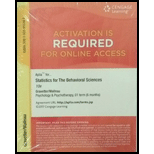
1. Insurance companies charge young drivers more for automobile insurance because they tend to have more accidents than older drivers. To make this point an insurance representative first determines that only 15% of licensed drivers are age 20 or younger.
Because this age group makes up only 15% of the drivers, it is reasonable to predict that they should be involved in only 15% of the accidents. In a random sample of 80 accident reports, however, the represen tative finds 26 accidents that involved drivers who were 20 or younger. Is this sample sufficient to show that younger drivers have significantly more accidents than would be expected from the percentage of young drivers? Use a two-tailed test with a = .05.
If the sample sufficient to show that younger drivers have significantly more accidents than would be expected from the percentage of young drivers using a two-tailed test with
Answer to Problem 1P
Solution:
Since np and nq = 12 >5 so using the Binomial test and Z scores is valid with
Explanation of Solution
Given:
Insurance companies charge young drivers more for automobile insurance because they tend to have more accidents than older drivers. In a random sample of 80 accident reports, however, the representative finds 26 accidents that involved drivers who were 20 or younger.
Calculations:
The null hypothesis states that proportion of accidents in population is same as proportion of young drivers(15%).
Conclusion:
Justification:
The test concludes that the null hypotheses about the population proportion of 15% of licensed young drivers who are involved in accidents are actually significantly different from 15%. The sample has actually 32.5% of young drivers who commits accident. The sample has enough evidence to refute the hypothesis of 15%.
Want to see more full solutions like this?
Chapter 18 Solutions
Statistics for Behavior Sciences - LMS MindTap
 Holt Mcdougal Larson Pre-algebra: Student Edition...AlgebraISBN:9780547587776Author:HOLT MCDOUGALPublisher:HOLT MCDOUGAL
Holt Mcdougal Larson Pre-algebra: Student Edition...AlgebraISBN:9780547587776Author:HOLT MCDOUGALPublisher:HOLT MCDOUGAL Glencoe Algebra 1, Student Edition, 9780079039897...AlgebraISBN:9780079039897Author:CarterPublisher:McGraw Hill
Glencoe Algebra 1, Student Edition, 9780079039897...AlgebraISBN:9780079039897Author:CarterPublisher:McGraw Hill College Algebra (MindTap Course List)AlgebraISBN:9781305652231Author:R. David Gustafson, Jeff HughesPublisher:Cengage Learning
College Algebra (MindTap Course List)AlgebraISBN:9781305652231Author:R. David Gustafson, Jeff HughesPublisher:Cengage Learning


